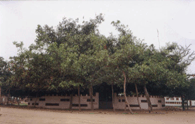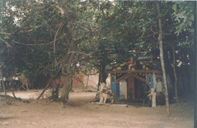|
PanchaSakhā Literature - composed works of the five Saints


SwetaBata: symbolizes Satya Yuga SiāliLatā: symbolizes Dwāpar Yuga
Satya Sweta-Bata rahiba mora, Tretayā-Aswashtha thiba ābara
Satya Tretayā duhen misijiba, aau Kalpa-Bata sadā nāma hoiba
Aau jete kalpa nei aasiba bhakta tora, aau Sākhyāte purna hoiba taankara
Dwāpara Siāli sākhsi jee ...
aau Mānava sharira sebele hoibi, Nayana mo chakaa-aakhi jee ...
Satya Peepal-tree of mine will stay, Tretaya Peepal-tree will be there before
Satya Tretaya both will mix (come) together, and will always have the name Kalpa-bata
And whatever wishes your devotees will bring, on Sakhshat (meeting) their's will be fullfilled
Dwaapara Siali is the witness ...
And I will take the Human form that time, The round-eyed (Lord Jagannath) is my eye ...
(part of a spontaneous song by Baba)
The Pancha Sakhaa are the direct disciples of Shri Chaitanya. Along with another great seer Shri Arakhsita Das, they are called also as sada-goswami (six Lords). These five saints believed in Vaishnavism and also cultured and developed other beliefs about the body, the mind, the soul, and the "Parambrahm" (the supreme Soul). They have composed numerous manuscripts, maalikas, devotional poems, sadhana descriptions, and other religious scriptures for the welfare of the mankind. Additionally, many prophecies about the yuga karma, the devotees, and the disciples are described by these seers in there numerous literature. Most of the literature were written in hand on palm-leaves using the Devanagari or the Oriya script.
The two prime works from the five writers are the Bhāgavata by Jagannath Das and the Jagamohana Rāmāyana by Balarām Das. Till today Jagannath Dasís Bhāgavata is the most valued book in Oriya literature. Besides this great work, he (Jagannath Das) also composed Artha Koili, Darubrahma Geetā, Shunya Bhāgabata, Dhruba Stuti etc.
Balaram Das, apart from Jagamohana Rāmāyana, has also composed various works such as the Lakshmi Purāna, Vendāntasāra Guptagitā, Nāma-māhatmya,
Bhāva samudra, Sisu Veda, Kamalalochana Chautisā, Kānta Koili etc.
Shri Ananta Das, also known as Shishu Ananta Das has composed various devotional literature, e.g., Chumbaka malikā, Nilagiri charita, Hetu Udaya Bhāgabata, Artha Tāreni Prasnottara, Anākāra Samhitā, Bhaktimuktipradāyaka Geetā etc.
Similarly, Shri Jasovanta Das composed Shiba Shirodaya, Premabhaktibrahma Geetā, Ātmaparatey Geetā, Gobindachandra etc.
Shri Achyutananda Das was the most prolific writer of the Panchasakhas and has written numerous books (called as pothi's), believed not in one life but in many successive lives. He is known as the Mahapurusha, which means - a great man. Mahapurusha Achyutānanda was a shunya sadhak and had acquired immense knowledge about almost every aspect, i.e., spiritualism, ayurveda (Indian healing medical science that uses only natural resources & herbs), various other sciences, and social regulations. Out of the all high-valued literature, depicting mysterious occult as well as simple explanations for noble life, to name a few are: Shunya Samhitā, Chaurāshi Yantra, Guru bhakti Geetā, Khila Haribamsa, Gupta Bhāgabata, Kaivarta Geetā, Kāla Nirghanta, Tera Janma Sharana, Brahma Ekahshara Geetā, Gopāla Ogāla, Bhāva Samudra, Garuda Geetā, Brahma Shankuli, Ananta Bata Geetā, Kali Kalkpa Geetā, Asta Gujjari, Gujjari Rāsa, Brahma Kundali, Mahagupta Padmakalpa, Chausathi Patala, Chayalisha Patala, Chabisa Patala, Dasa Patala, Neetya Rāsa, Manmatha Chandrika, Shiva Kalpa, Achyutananda Janma Sharana, Chitta Bodha, Rāsa Māla, Pancha Sakhaa Bhajana etc.
The Shunya Samhita is regarded as one of his top compositions that dealt with supreme spiritual science where the description is recorded as a conversation between Guru Achyuta and Shishya Ram Das. [We, recently (end-2014), politely asked Sri Achyuta about the whereabouts of the original version of this book and he kindly revealed its whereabouts and referred to a poor pious family whose members are his devotees. In this family, the Pandulipi (manuscript) is in adverse conditions (slowly decaying); hopefully, this can be recovered and preserved so that it is not lost with time. Being devotees, this family does not just sell off the manuscripts to un-related entities for money, like many antique smugglers do, or will not give away in wrong hands, but the manuscript needs proper attention and preserving action. These are part of our culture and heritage that need conservation.
The term Chaurāshi Yantra means "84 Yantras", which specifically is related to the '84 yantras' embedded within the Human Body, the later itself is ~84 fingers in length and each yantra is located for each finger-length space. However, the most popular one is an Oracle of Prophecies named as Bhavishya Malikā, which reveals the major events of the future partly for the whole world. Among prophecies also are Āgata bhabishya lekhanā, which literally means Writings about the coming (i.e. future) and Bhavishya Parārdha which literally means Chapter after the coming. To the astonishment of many, many important predictions given in Bhavishya Malikā, some 500-600 years before, have actually matched the reality in recent years and in the last century. About the crucial Yuga-Karma and the Identification of his Disciple and the primary devotees, he has given the Jaiphula Malikā. In this manuscript (written some 500 years before), he has given description about his disciple Ram Das who will fulfill his work now as Buddhanath Das. Also have been identified many other eternal devotees including the Pundit at the Kakatpur who operates the Tamrapothi, Arta Baba at Konark, and the disciples of Baba Shri Buddhanath Das. In his Chakadā Madāna (this he calls Bhakta GanthiDhana or The Gem for Devotees), he describes briefly the identification of his devotees and the upcoming YugaKarma, and has repeatedly referred to follow the Jaiphula Malikā for more details about identification of the prime devotees and his disciples.
Shri Arakhsita Das, the presiding seer of Olasuni, had written the Mahimandala Gitā, the Bhakti Tikā, the Saptānga Abadhuta Samhitā, and the Tatwa Sara Gitā etc.
Shri Ram Das, the disciple of the Pancha Sakhaa (five friends) and Sada Goswami (Sada Goswami) and the previous incarnation of Baba Shri Buddhanath Das, had composed Bhagavat Chandrikā, Dadhyatā Bhakti Rasāmruta etc. The relatively unknown unpublished Bhagavat Chandrika is a deep spiritual manuscript where Yogi Ram Das had explained the Sharira-Tatva (the body principles), including the 49 winds inside the body, the 25 properties of human, the properties of the bones including the sola-dambaru (spinal bones) and veins, evolution of the human body in the womb and entry of the soul, and mantras. We are making every effort to have this work published, and the publication process is underway. Once it is available, we will keep our readers informed, in this page. The Dadhyata Bhakti is a book about staunch devotees and the book is published by Dharma Grantha Store (Cuttack).
It is not overly an easy task to interpret the meanings intended in these "Samhita"s, "Malika"s, and the future-prophecies, as the statements are cryptic in nature, and also it requires some Oracular capabilities to analyze the statements. However, some work has been done to that respect :
In India, you may contact local publishers in Cuttack (e.g., Dharmagrantha Store) for copies of the interpretations in Oriya language.
From outside India, interpretations of some of the related literature are probably preserved and available at "The University of Heidelberg", Germany:
- Manuskript Nr. 408 "des Orissa Research Projects", Bhubanesvara, Orissa, Indien. 265 mss 16/408
(Sunya Samhita by Achyutananda Das) - [s.l.] : [s.n.], [circa 1970]. - 254 Bl.
- Manuskript Nummer 833 "des Orissa Research Projects", Bhubanesvar, Orissa, Indien. 265 mss 16/833
(Bhavishya malikā by Acyhuta Das)
- Manuskript Nummer 220 "des Orissa Research Projects", Bhubanesvar, Indien.265 mss 16/220
(Agata bhabisya lekhana by Acyhuta Das)
- Manuskript Nummer 182 "des Orissa Research Projects", Bhubanesvar, Indien. 265 mss 16/182
(Guptagitā by Balaram Das)
- Manuskript Nummer 193 "des Orissa Research Projects", Bhubanesvar, Indien. 265 mss 16/193
(Bhagavaccandrika by Ram Das)
- Manuskript Nummer 288 "des Orissa Research Projects", Bhubanesvar, Indien. 265 mss 16/288
(Balabhadra boli by Ram Das)
- Manuskript Nummer 697 "des Orissa Research Projects", Bhubanesvar, Orissa. 265 mss 16/697
(Chumbaka malikā by Ananta Das)
- Manuskript Nummer 823 "des Orissa Research Projects", Bhubanesvar, Orissa, 265 mss 16/823
(Dardhyata bhakti by Ram Das)
- Manuskript Nummer 645 "des Orissa Research Projects", Bhubanesvar, Orissa. 265 mss 16/645
(Dardhyatabhakti Rasamruta by Ram Das)
- Manuskript Nummer 187 "des Orissa Research Projects", Bhubanesvara, Orissa. 265 mss 16/187
(Nilagiri carita / by Ananta Das)
- Manuskript Nummer 372 "des Orissa Research Projects", Bhubanesvar, Orissa. 265 mss 16/372
(Sisuveda by Balaram Das)
General link of University of Heidelberg Bibiliothek (library)
Specific link of Orissa Bibiliography at:
South Asian Institute (SAI), University of Heidelberg
The links to SAI, Univ. Heidelberg and Dharmagrantha store are provided for the convenience of our readers. However, we do not have any working relation with either the library or the book store.
Please check our Collection->Manuscript page for any manuscripts made available electronically by Garoi Ashram.
Baba Shri Buddhanath Das is a spontaneous Poet also. He, out of devotion, sings out devotional songs with spiritual truths completely spontaneous. Unfortunately they are hard to be collected or stored as Baba is completely spontaneous. There is no way that they can be repeated and recorded. However, over a period of time some of the songs have been recorded and printed in the form of a hand-book. The book is entitled "Bhakti Taranga", which means "waves of devotion". The publishers are:
Jagannath Sansad
Shri Gobardhana Pitha Garoi Ashram
Post-Korua, Via- Naungaon
Dist.- Jagatsinghpur, Orissa, India
If you are interested in this book, which is in Oriya language, please directly contact the publishers. Further exact information may be asked by phone (see contact page for number). In the meanwhile, we are attemtping to scan and provide an e-version (PDF) of the book, which will take some time [cited: 18-Jan-2015].
Information about other books may not be provided by email, because the web-designer has no direct working contact with the publishers of the book or any of the sources (publishers, library) mentioned here.
|


